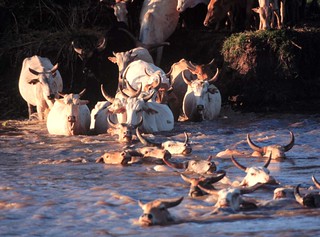 |
| Orma boran cattle crossing a river. A new study has mapped the global hotspots of poverty and human-animal diseases (photo credit: ILRI/R. Dolan). |
A new study has mapped global hotspots of poverty and zoonoses (diseases transmissible between animals and humans) and found that a relatively small number of countries – notably India, Ethiopia, and Nigeria – have a disproportionate share of poor livestock keepers and zoonotic disease burden.
The study also revealed that the burden of human and animal diseases can be linked to just a few zoonoses. For this reason, targeting these zoonoses is likely to be an effective use of scarce resources.
These and other findings are contained in a new collaborative research report, Mapping of poverty and likely zoonoses hotspots, by the International Livestock Research Institute (ILRI), the Institute of Zoology (UK) and the Hanoi School of Public Health in Vietnam.
The report to the UK Department of International Development (DFID) presents data and expert knowledge on poverty and zoonoses hotspots to inform prioritization of study areas on the transmission of disease in emerging livestock systems in the developing world, where prevention of zoonotic disease might bring greatest benefit to poor people.
In addition to mapping the hotspots of zoonoses and poverty, the study also identified gaps and opportunities for research to reduce the burden of disease for the zoonoses and regions identified.
These include:
- better understanding of the implications for intensification and emerging markets on zoonoses;
- models for zoonoses control in emerging markets;
- ecosystem models for management of zoonoses with a wildlife interface;
- improvement of surveillance for existing and new diseases;
- understanding the impacts multiple burdens of zoonoses in order to better allocate resources; and
- technologies and innovation for detection, diagnosis, prevention, treatment and response.

No comments:
Post a Comment